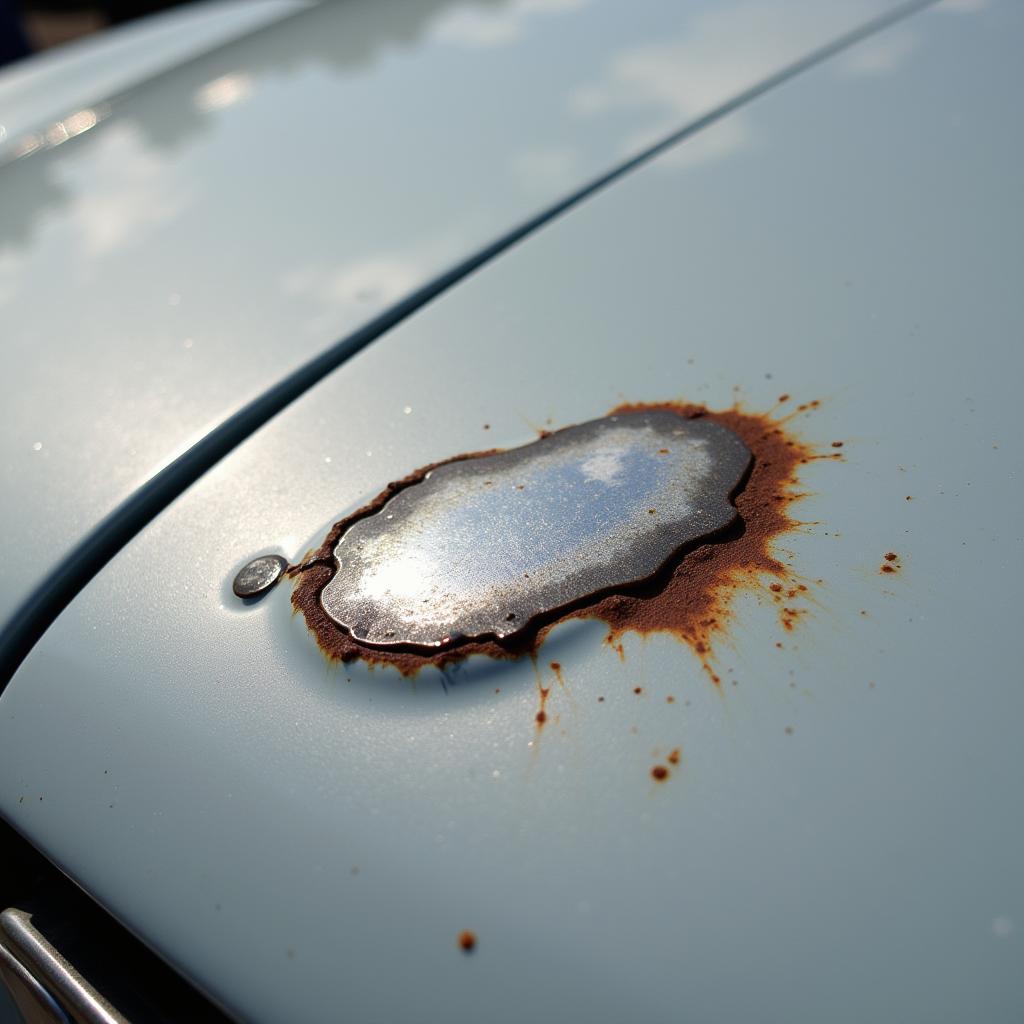Repairing paint chips on your car is essential not only for aesthetics but also for protecting the underlying metal from rust and corrosion. This guide will provide you with everything you need to know about how to repair paint chips on a car, from identifying the damage to choosing the right repair method and achieving a professional-looking finish. We’ll cover DIY solutions, professional options, and tips for preventing future chips.
Understanding Car Paint Chips
Before diving into repair methods, it’s important to understand what paint chips are and why they occur. Paint chips are small areas where the paint has been removed, exposing the bare metal underneath. They can be caused by a variety of factors, including rocks, road debris, insects, and even minor collisions. Ignoring these seemingly small blemishes can lead to significant problems down the road, such as rust formation, which can compromise the structural integrity of your vehicle. The size and depth of the chip will determine the appropriate repair method. Small, superficial chips can often be addressed with touch-up paint, while larger, deeper chips may require more extensive repairs. Assessing the damage accurately is the first step towards a successful repair. Learn more about the best way to repair paint chips on car.
After washing and drying the affected area, carefully examine the chip. Is it a surface scratch, or has it penetrated to the primer or bare metal? This assessment will guide your repair strategy. For minor chips, a simple touch-up paint application might suffice. However, deeper chips might require sanding, priming, and even professional attention.
DIY Paint Chip Repair: A Step-by-Step Guide
For small to medium-sized chips, a DIY approach can be effective and cost-efficient. Here’s how to repair small car paint chips:
- Clean the Area: Thoroughly wash and dry the area around the chip. This removes any dirt or debris that could interfere with the repair process.
- Apply Touch-Up Paint: Using a fine-tipped brush or a touch-up pen, carefully apply the touch-up paint to the chipped area. Apply thin coats, allowing each coat to dry completely before applying the next.
- Level the Paint: Once the touch-up paint is dry, use a rubbing compound to carefully level the paint with the surrounding area. This will create a smooth, seamless finish.
- Wax and Polish: After leveling the paint, apply wax and polish to protect the repaired area and restore the shine.
Professional Paint Chip Repair
For larger or more complex chips, or if you’re not comfortable with a DIY approach, seeking professional help is recommended. A professional auto body shop has the expertise and equipment to handle more extensive repairs, including sanding, priming, painting, and clear-coating. They can also perfectly match the paint color to your car, ensuring a seamless and invisible repair. You can learn more about repairing paint chips on a car at dealership.
Many dealerships offer paint chip repair services. They often have specialized technicians and access to factory-matched paint, ensuring a high-quality repair. However, dealership repairs can be more expensive than independent auto body shops.
Preventing Future Paint Chips
While some paint chips are unavoidable, there are steps you can take to minimize the risk:
- Regular Washing and Waxing: Keeping your car clean and waxed provides a protective layer against the elements and minor abrasions.
- Parking Strategically: Avoid parking in areas prone to flying debris, such as construction zones or gravel roads.
- Using Paint Protection Film: Applying a clear paint protection film to vulnerable areas, such as the hood and bumpers, can help prevent chips and scratches.
Conclusion
Repairing paint chips on your car is a crucial step in maintaining its appearance and protecting it from further damage. Whether you choose a DIY approach or seek professional help, addressing paint chips promptly can save you money and hassle in the long run. Remember to assess the damage accurately and choose the appropriate repair method for the best results. Learn how to repair paint chip on car bumper.
FAQs
-
How much does it cost to repair paint chips on a car?
The cost varies depending on the size and number of chips, as well as the repair method used. DIY repairs can cost a few dollars for touch-up paint, while professional repairs can range from a few hundred to over a thousand dollars. -
Can I repair paint chips myself?
Yes, small to medium-sized chips can often be repaired with DIY methods using touch-up paint and rubbing compound. -
How do I prevent paint chips on my car?
Regular washing and waxing, strategic parking, and applying paint protection film can help prevent future paint chips. -
What happens if I don’t repair paint chips?
Unrepaired paint chips can lead to rust formation, which can compromise the structural integrity of your car. -
How do I find the right touch-up paint for my car?
The paint code for your car is usually located on a sticker inside the driver’s side doorjamb or in the owner’s manual. -
When should I seek professional help for paint chip repair?
For larger or more complex chips, or if you’re not comfortable with a DIY approach, it’s best to seek professional help. Find out more on how to repair car door paint chips. -
What is the best way to repair paint chips on a car? The best method depends on the severity of the chip. For small chips, touch-up paint may suffice. Larger chips may require professional repair.
Common Scenarios
- Scenario 1: A small rock chip on the hood. Solution: DIY touch-up paint application.
- Scenario 2: Several deep chips on the bumper. Solution: Professional repair at a body shop.
- Scenario 3: Scratches and chips on the door from a minor collision. Solution: Professional repair.
Further Reading
For more information, check out our articles on how to repair a paint chip on car bumper and the best way to repair paint chips on car.
For assistance, contact us via WhatsApp: +1(641)206-8880 or Email: [email protected]. Our customer service team is available 24/7.



